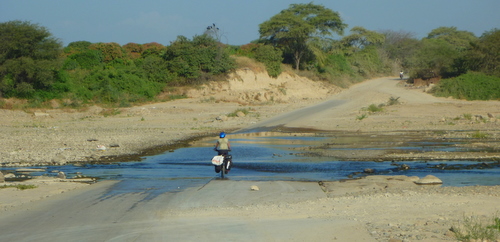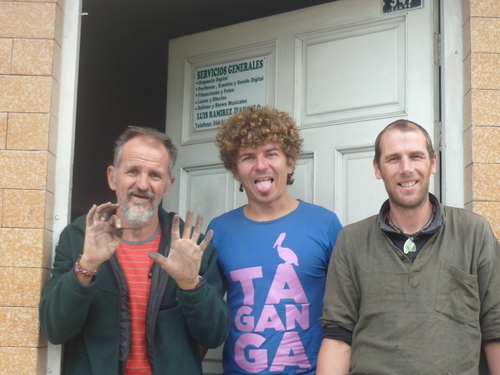We enjoyed our time in Ecuador, a beautiful country with big challenges for the cyclist but the time had come for something new, a change. On our arrival at the Peruvian border we were back to the lowlands. Macará, at 600 meters, is one of four border crossings between Peru and Ecuador and seems to be one of the more relaxed as border crossings go from what we had heard.

Crossing a border brings with it a lot of emotions, mainly excitement and curiosity at the prospect of all the change and undiscovered experiences which await. The first few days cycling in a new country awakens your senses to new sights and sounds, adapting to the new ways of the people, customs, habits and of course the new rules of the road dictated by the drivers! We cycled with all our senses on alert, anxious to observe the differences of the country which we had just entered. Peru felt like a mystery, an incognito land.

Peru is much poorer then its northern neighbour, Ecuador. And for brief instants I suddenly found myself catapulted back to my time spent in India. Here also exists a certain kind of chaos in the towns and villages which usually involves every kind of imaginable vehicle, cars, buses, tuc-tucs, bicycles, and horse carts fighting for space in the dusty streets. The smells, the noise, the dryness of the landscape and the glaring poverty were reminiscent of scenes from Northern India. So much so, I had to pinch myself to remember where I was.


Apart from the larger towns, the traffic was thankfully scarce and the temperatures high. The dry air and heat of the midday sun made for an easy first day’s cycling and we almost effortlessly clocked up 130km. As we pounded the pedals during our first few days, we watched the vegetation change from fairly lush, to sparse, to nearly non-existent, to nothing but endless sand in the Sechura desert of Northern Peru.



We cycled from dusty villages to the sand dune desert along the Pacific coast on paved and unpaved roads. A zone with little cycling interest unless you like cycling with a full-on head wind. It was a desolate area.






On a bike your first impressions of a country are always up close and personal compared to when travelling by bus. On our second day, we stopped at a deserted village for some lunch and luckily enough found a woman willing to feed us. We waited while she cooked up some rice and chicken and were kept amused by local children coming from school. They stared at us in a semi catatonic state wondering if we have landed from another planet. Martin started to kick a ball with them and they slowly started to open up and started asking questions.. and didn’t stop!




We passed through permanently-under-construction-looking-villages, with animals looking for every scrap of food they could find and wide-eyed children peering from behind closed doors.

The North of Peru has a lot of hidden gems. Some of the most important archaeological sites are located in the coastal desert of the northern coast and in the southern Andean Highlands and explains why Northern Peru is known as the Egypt of South America. En route to Chiclayo, we were lucky enough to visit the Tucumbe pyramids, structures built by pre-Colombian cultures from around 1100AD. They looked like natural, albeit unusual rock formations but were in fact man made structures.



The temperatures began to sore high into the mid 30´s again and even the cows needed to shade from the blistering heat! I knew this also signaled the transition from hot to cold showers.


On a cyclist’s ‘roadmap’ the coast of Peru is known for two things: a little hamlet on the coast called Paijan and ‘Lucho’ in Trujillo.

We were warned about one particular town on our route as far back as Colombia. Paijan, 50 km north of Trujillo on the Pan-American highway has a reputation as a place to be avoided by cyclists. ‘Ladrones’ or robbers frequent the territory and seem to have developed a fondness for targeting the vulnerable cyclist and relieving them of their belongings, everything, bikes and all. A cyclist’s nightmare! Most problems have occured when cyclists have stopped in the town allowing these thugs to get organised and rob the cyclist on the outskirts of town. Solution: take the chance, organise a police escort or get a bus. We opted for the latter, to be sure, to be sure. We loaded our bikes on a bus bound for Trujillo for this stretch of the journey and did not look back. Why take the chance ..

It was getting dark as we arrived in Trujillo and we had a house to find, the ‘casa de ciclista’. We asked two policemen on a motorbike for directions and we ended up having our very own police escort through the city and they brought us safely to our destination as we zipped through the labyrinth of streets. Despite the reputation that the police seem to have in Latin America of being corrupt, so far we have found this not to be true. We bid them farewell and settled down for the night in the casa de ciclista. We met the famous Lucho the next day.

Martin spent two days of hard graft on our bikes and we once again hooked up with Geoff and Rosemary, two Australian cyclists we met in Ecuador and our new Colombian friend.



The Casa de Ciclista
For 20 years, Lucho has been opening his home to cyclists and there is a long legacy of hospitality here. The Casa Amistad (friendship house), the original Casa del Ciclistas in Latin America, has been providing a refuge for cyclists since the mid-80s. Lucho, a former professional cyclist and a bicycle mechanic, provides support to those passing north or south along the Pan-American highway.


Heinz Stucke’s is a bit of a celebrity in the bike touring world. He has stayed at the Casa de Ciclista here a number of times. He left Germany in 1962 and has been pedaling ever since. Between 1962 and 2006 he rode 539,000 kilometres in 192 countries. He’s still cycling…


The time to leave has arrived. We head back towards the mountains tomorrow, 28th July, known as Fiestas Patrias which commemorates the day that Peru gained its independence. During the whole month of July, homes, office buildings, public and private institutions, schools, and restaurants display the national flag.

The next leg of the trip promises to be an adventure. We cycle for a few more days through the Sechura desert and then head up to the Cordillera Blanca, following the river to Huaraz. It will be a fantastic journey through deserts, canyons and river valleys, and some great cycling along craggy white peaks of over 6000m altitude. We need to find some coco leaves for the altitude!
And so we say goodbye to this oasis and head back to the second highest mountain range in the world.


Powered by Qumana